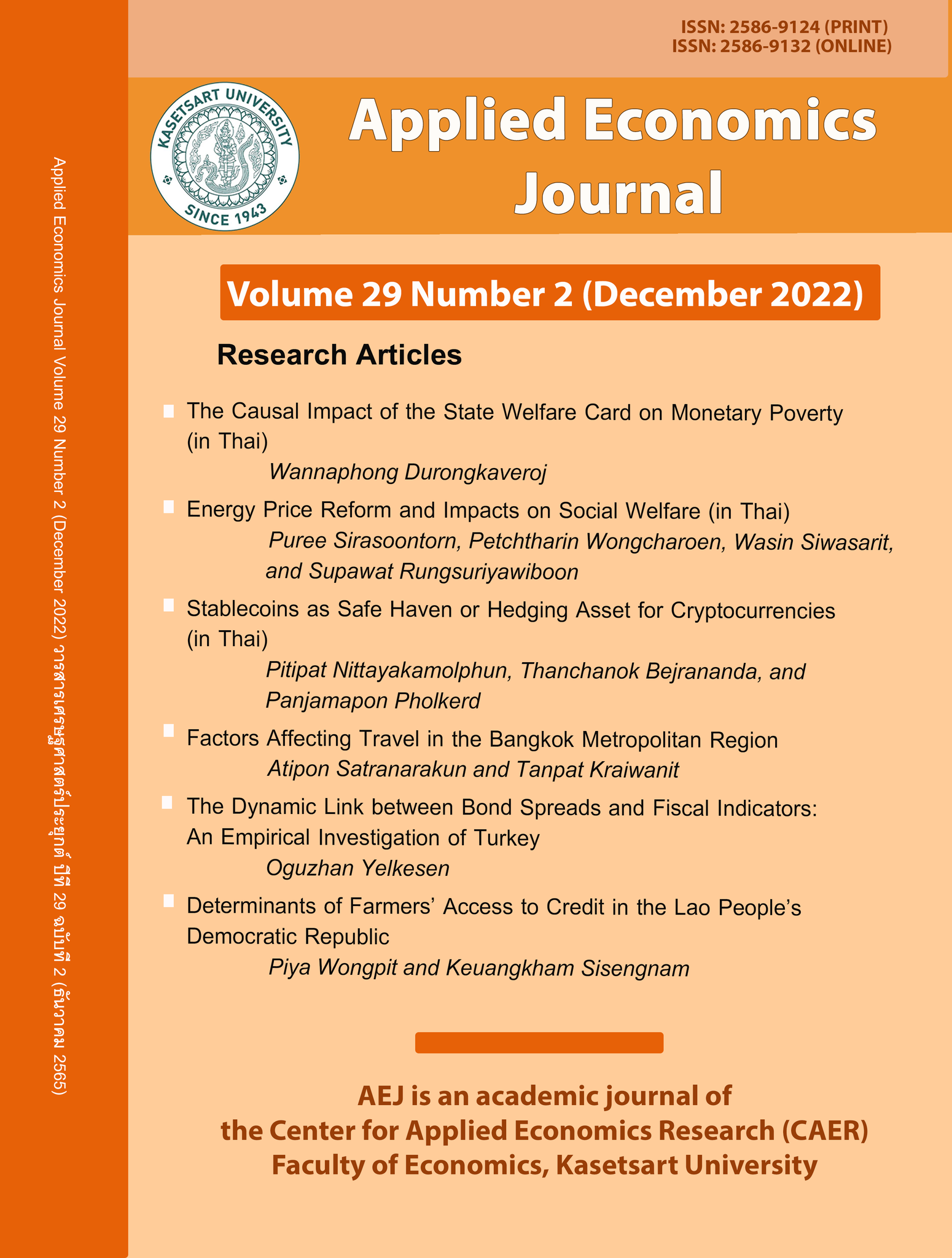Factors Affecting Travel in the Bangkok Metropolitan Region
Main Article Content
Abstract
This study aims to explore the behavior of Bangkok Metropolitan Region residents when using transport and to examine the factors affecting their travel. The population comprise commuters residing in the Bangkok Metropolitan Region who use transportation in their daily lives. The data were collected through an online survey conducted between December 2021 and March 2022 from a sample of 618 commuters, selected by convenience sampling. The analysis is divided into three parts. In the first part, we explore commuters’ transportation behaviors using descriptive statistics, and in the second and third parts, using a multivariate analysis of variance, we examine the factors that influence travel in the Bangkok Metropolitan Region in terms of private cars use and number of transfers required on public transportation. The findings show that only a small percentage of people used public transport only; most people used private vehicles or both public and private transport. Commuters spent 36.24% of their monthly living costs on transportation. Furthermore, type of residence, whether a commuter took the bus, and income were all significant factors that influenced travel behavior. The results suggest that, in order to increase the number of public transportation users, public transportation charges should be lower than parking fees and vehicle maintenance expenditures, and the operation and amenities of buses must be enhanced to meet the passengers’ demands.
Article Details

This work is licensed under a Creative Commons Attribution-NonCommercial-NoDerivatives 4.0 International License.
The paper is published under CC BY-NC-ND, in which the article is freely downloaded and shared in its original form non-commercially and its citation details are identified.
References
Bak, M., Borkowski, P., & Pawlowska, B. (2012. Types of solutions improving passenger transport interconnectivity. Transport Problems, 7(1), 27–36.
Burian, J., Zajíčková, L., Ivan, I., & Macků, K. (2018). Attitudes and motivation to use public or individual transport: A case study of two middle-sized cities. Social Sciences, 7(6), 83.
Charoentrakulpeeti, W., Sajor, E., & Zimmermann, W. (2006). Middle-class travel patterns, predispositions and attitudes, and present-day transport policy in Bangkok, Thailand. Transport Reviews, 26(6), 693–712.
Chen, J., & Li, S. (2017). Mode choice model for public transport with categorized latent variables. Mathematical Problems in Engineering, 2017(1), 1-11.
Chowdhury, S., & Ceder, A. (2013). The effects of interchange attributes on public-transport users' intention to use routes involving transfers. Psychology and Behavioral Sciences, 27(1), 5–13.
Chowdhury, S., & Ceder, A. (2015). The effects of travel time and cost savings on commuters’ decision to travel on public transport routes involving transfers. Journal of Transport Geography, 43, 151–159.
Doori, A. A. (2017). Waiting time factor in public transport by binary logistic regression. Australian Journal of Basic and Applied Sciences, 11, 72–76.
European Commission. (n.d.). The importance of the private car. Retrieved from https://road-safety.transport.ec.europa.eu/statistics-and-analysis/statistics-and-analysis-archive/miscellaneous/importance-private-car_en
Gadzinski, J. (2016). The impact of accessibility of public transport on the transport behavior of inhabitants-Example of Poznan agglomeration. Transport Geography Papers of Polish Geographical Society, 19(1), 31–42.
Grise´, E. & El-Geneidy, A. (2019). Transferring matters: Analysis of the influence of transfers on trip satisfaction. Transportation Research Record, 2673(9), 254–265.
Guo, Z. (2013). Does residential parking supply affect household car ownership? The case of New York City. Journal of Transport Geography, 26, 18–28.
Health and Social Care Information Centre (2015). Statistics on obesity, physical activity and diet: England 2015. Retrieved from https://digital.nhs.uk/data-andinformation/publications/statistical/statistics-on-obesity-physical-activity-and-diet/statistics-onobesity-physical-activity-and-diet-england-2015
Legrain, A., Eluru, N., & El-Geneidy, A. (2015). Am stressed, must travel: The relationship between mode choice and commuting stress. Transportation Research Part F: Traffic Psychology and Behavior, 34, 145–150.
Li, J., Lo, K., & Guo, M. (2018). What influences the choice between private car and public transport for shopping trips? Impact of socio-economic and built environment factors. Journal of Asian Energy Studies, 2, 28-42.
Liu, T., & Xu, M. (2018). Integrated multilevel measures for the transformation to a transit metropolis: The successful and unsuccessful practices in Beijing. Advances in Transport Policy and Planning, 1, 1–34.
Loong, C., & El-Geneidy, A. (2016). It’s a matter of time: An assessment of additional time budgeted for commuting across modes. Transportation Research Record: Journal of the Transportation Research Board, 2565(1), 94–102.
Marks, D. (2019). Understanding Bangkok's traffic woes. Bangkok Post. Retrieved from https://www.bangkokpost.com/opinion/opinion/1762349/understanding-bangkoks-traffic-woes
National Statistical Office of Thailand. (2019). Survey of socio-economic status of Thai households in the first half of 2019. Bangkok, Thailand: Text and Journal Publication Company Limited.
Office of Transport and Traffic Policy and Planning, Ministry of Transport of Thailand. (2018). Transport Infrastructure Report 2018. Retrieved from https://www.otp.go.th/uploads/tiny_uploads/PDF/2562-07/25620723-ReportTransportInfrastructure-2561.pdf
Pita, P., Chunark, P., & Limmeechokchai, B. (2017). CO2 reduction perspective in Thailand’s transport sector towards 2030, Energy Procedia, 138, 635-640.
Qi, X., Wu, G., Boriboonsomsin, K., & Barth, M. J. (2019). Data-driven energy efficient driving control in connected vehicle environment. In Y. Wang & Z. Zeng (Eds), Data-driven solutions to transportation problems (pp. 11–49). Elsevier.
Schmitt, L., Currie, G. & Delbosc, A. (2013). Measuring the impact of unfamiliar transit travel using a university access survey. Transport Policy, 30, 301–307.
Schmitt, L., Currie, G. & Delbosc, A. (2015). Lost in transit? Unfamiliar public transport travel explored using a journey planner web survey. Transportation, 42(1), 101–122.
St-Louis, E., Manaugh, K., van Lierop, D., & El-Geneidy, A. (2014). The happy commuter: A comparison of commuter satisfaction across modes. Transportation Research Part F: Traffic Psychology and Behaviour, 26, 160–170.
The Bureau of Planning, Department of Highways. (2021). Project to solve traffic problems in the Bangkok metropolitan area and major cities. Retrieved from http://planning.doh.go.th/projects/sub_project_3
Zajickova, L., Vozenilek, V., Burian, J., & Tucek, P. (2014). Demand specifications for geodata within a public transport system. Proceedings of the SGEM2014 Conference (pp. 555–62). Albena, Bulgaria.


